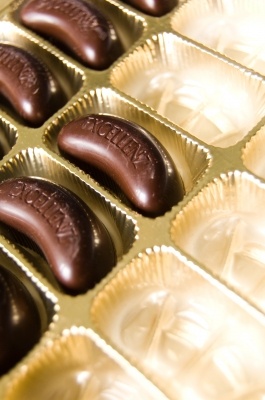Another Helping of Food Related Weirdness – 7

Meanwhile, here is someone who is taking the chocolate maker’s art way too literally. Jean Zaun of Fredericksburg in Pennsylvania uses a mixture of dark and white chocolate, food colouring and confectioner’s glaze to recreate famous works of art, including the frames, in a deliciously edible form. Her subjects have included the works of Van Gogh, Munch and Da Vinci, as well as a portrait of Ozzy Osborne commissioned by his wife. While the chocolate artworks are edible, Zaun believes they should be souvenirs rather than snacks. “They are meant to be consumed by the eye, not the stomach.” Zaun Explained (Daily Mail).
And the misuse of materials won’t stop there, at least not if Dr. Peter Eisner of the Fraunhofer Institute gets his way. Concerned that meat consumption is both unhealthy and bad for the environment, Dr. Eisner has started looking for ways to supplement or replace animal products with vegetable equivalents. His first success is a milk substitute derived from lupins that can even be used to make cheese, meanwhile co-worker Daniela Sussmann has extracted a protein from the seeds gives low-fat sausages more of the sensation of their unadulterated competition. Eisner reckons that our ever growing appetite for meat could one day be disastrous, arguing that the resources needed to produce 1 kilo of meat could instead yield 80 to 100 kilos of fruit or vegetables (Softpedia).
Not content with adulterating our sausages, science also threatens an end to one of the mainstays of comedy, the banana skin. Brazilian boffin Milena Boniolo from the University of Sao Carlos was so disgusted by the tons of banana skins discarded each week in her city alone that she decided to find a better use for them. The crafty chemist soon discovered that, when dried and ground into powder, banana skins make an excellent decontaminant for polluted water, making them a cheap and effective alternative to current industrial techniques like magnetic nanoparticles (Treehugger).
Another unexpected use for food waste now. Yeast extract, once the waste product of beer manufacture, then the main ingredient of popular spreads like Marmite, now looks set to become the unlikely nemesis of the UK’s far-right British National Party (BNP). After the copying the Marmite brand’s “love it or hate it” slogan in their election campaign, and featuring a giant Marmite jar in a TV stunt, the BNP were sued for copyright infringement by brand owner Unilever. A reported out of court settlement of £170,000 ($260k) may leave the party bankrupt (Marketing Week).
And what helping of food related weirdness is complete without bacon? So let’s finish with a double helping. First up we have the KFC employee from Sydney in Australia, who attacked a customer for demanding a slice of bacon with their burger, though to be fair the customer was in one of the chain’s Halal-friendly outlets, so there is normally no bacon on the premises (TVNZ). Meanwhile Japan have introduced a meat processing robot able to debone up to 500 hams per hour, as this video demonstrates (Reuters).
(Image: graur razvan ionut / FreeDigitalPhotos.net)
Comments
Give the robots knives and how long do you think it will take them to decide that WE have too many bones!!!! :ahhh:
Posted by Tyrusguy on 01/10/11 at 04:28 PM
Dennis Moore was being helpful after all. Those poor peasants could have survived on lupins!
Posted by driven2succeed on 01/10/11 at 06:24 PM
If scientists can finally produce a more productive and hearty Criollo tree then the last 40,000 years of advancement will have all been worth it.
Posted by Expat47 in Athens, Greece on 01/11/11 at 01:40 AM
Wait.... A burger from Kluckin' F....in' Chicken?
Posted by Expat47 in Athens, Greece on 01/11/11 at 01:41 AM
KFC link is broken; looks like an HTML gremlin replaced the target URL with that for the Marmite/BNP story. The correct URL is here: http://tvnz.co.nz/world-news/kfc-employee-attacks-customer-over-bacon-3993310
Speaking of the BNP, I'm glad about this. The BNP is a bunch of fascists.
But I'm even happier about the Criollo story. SCIENCE!
Speaking of the BNP, I'm glad about this. The BNP is a bunch of fascists.
But I'm even happier about the Criollo story. SCIENCE!
Posted by venomlash on 01/11/11 at 09:38 AM
Link fixed now, thanks VL.
Posted by Dumbfounded on 01/11/11 at 10:18 AM
better chocolate? large quantities of better chocolate?? oh expat, isn't it marvolous??? 😛
humans are omnivores, we are meant to eat both plant and animal foodstuffs. get the f%^k over it treehuggers! geesh!
dude was trying to get a bacon burger at kfc? i guess he goes to taco bell for an eggroll
i agree kdp, unfortunately the the part where the deboning robot became aware and linked with other computers world wide to become skynet was left on the cutting room floor. (but atleast they won't know dumbfounded's post here brought all the computers' awareness together for the first time, right here on wu!! :gulp: )
exceptional post dumbfounded darling! you are still the cat's meow love.
humans are omnivores, we are meant to eat both plant and animal foodstuffs. get the f%^k over it treehuggers! geesh!
dude was trying to get a bacon burger at kfc? i guess he goes to taco bell for an eggroll
i agree kdp, unfortunately the the part where the deboning robot became aware and linked with other computers world wide to become skynet was left on the cutting room floor. (but atleast they won't know dumbfounded's post here brought all the computers' awareness together for the first time, right here on wu!! :gulp: )
exceptional post dumbfounded darling! you are still the cat's meow love.
Posted by Patty in Ohio, USA on 01/11/11 at 06:47 PM
Commenting is not available in this channel entry.

Category: Agriculture | Animals | Farming | Art | Food | Bacon | Candy | Junk Food | Nutrition | Vegetables